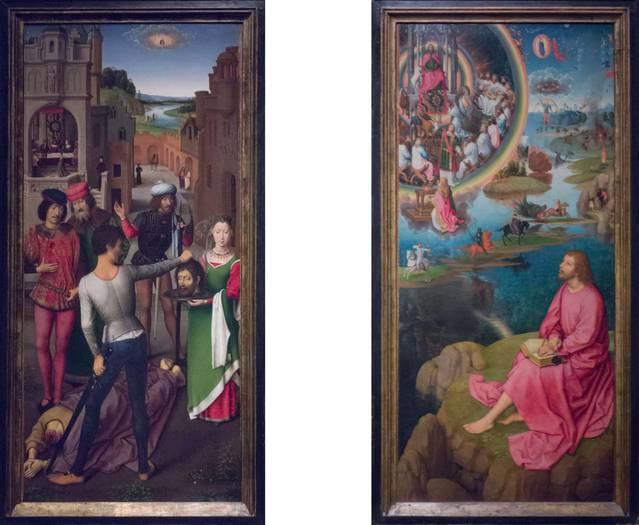organisation of the pictorial narrative around the legends of John the Baptist, John the Evangelist and the Old St John's Hospital
a number of small scenes
The narrative is structured around a number of small scenes
- depicting the two legends,
- of John the Baptist
- and John the Evangelist
- and representing the Crane's square of Bruges linked to the St. John's Hospital.
the narrative begins with the capitals of columns
The two legends begin spatially with the sculpted scenes above each saint in the column capitals.

the narrative continues with small scenes in the distance
This manner of ordering the composition, which is found in many of Memling's other works, takes up the layout techniques of illumination note 7: the various scenes are tiered up to a very high placed horizon.
Small scenes take place in the distant within the various framings operated by the columns.

on the left, scenes from the Legend of John the Baptist, on the right, those of John the Evangelist
the narrative concludes with each of the two inner shutters
The narrative of the two legends then continues in each of the two inner panels.

On each shutter, an episode forms a main scene in the foreground, completed in the narrative by small scenes in the distance.
- on the left inner shutter, John the Baptist has just been beheaded by Herod's order,
- on the right inner shutter, John the Evangelist receives the «unveiling» of the text of The Revelation in Patmos.
Crane's square, symbolises the St. John hospital
The view from the Crane's square and St. John's Church, in the background to the right of the drapery of honour behind the virgin, behind John the Evangelist refers directly to the religious leaders of the hospital sponsors of the work and to the history of the commissioning institution.

Two brothers from the hospital are represented measuring the imported bordeaux wine arriving in Bruges.
This reminds us that the hospital was entrusted by the city around with a communal charge, the «right to gauge» from which the institution had its income.